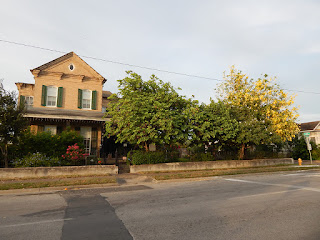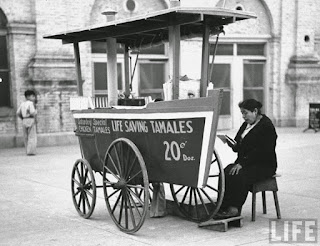Tuesday, June 30, 2015
Friday, June 26, 2015
Snakeville's Gypsy Joe
(Photos from Robert Runyon Collection online. Joe Guerrero (as identified in photos on RRunyon webpage) and Gypsy Joe (described in "Rattling Yours...") may not be the same person. If you can detect a missing finger in any of these photos then you'll solve a mystery)
Gypsy Joe Guerrero had a missing finger where he chopped it off after being bitten by a snake. He was a curandero of sorts who had a cure for any ailment. In Rattling Yours… W.A. King, Jr. wrote, “Every other tooth in Joe’s mouth was 24-carat gold and his ears were pierced to make him look like a genuine gypsy which he wasn’t.” Joe later went to Tierra Blanca, Vera Cruz and began supplying the snake farm with snakes and other animals. Joe was also illiterate and sometimes sent mail. Letters from Joe were always difficult to make sense of. One time Joe requested a box full of pepper. Sending pepper into Mexico made as much sense as sending snow to Alaska so The Snake King sent a letter to Joe asking him if he wanted red pepper or black pepper. Joe’s wrote back to say, “I dunt kere wot color peper you sand me. Jus so its toylet peper!” Another time The Snake King asked W.A. Jr. to place an order for 2 or 3 monkeys. The Snake King asked Jr. to write it in Spanish, short and sweet, just to make sure Joe got it right. In Spanish, the word “or” is just an “o” which could easily be mistaken for a zero. Joe wound up sending 203 monkeys.
Thursday, June 25, 2015
2015 Update on Los Laureles Ranch House at Mittie Cultural Park
The Los Laureles Ranch House project is expected to be complete by the end of 2015. It will serve as a museum to interpret the history of south Texas ranching families and community-use building for special events during the day or evening. The wraparound porch provides shade and protection from rain all year round. Because it sits well above the ground, visitor's are given a wider vantage point for views of the park.
You might recall when the house arrived from Los Laureles (King Ranch) and sat for a period of time it sparked controversy from a few well-meaning but very misinformed individuals. Check this blog for the most accurate information and updates on Los Laureles Ranch House.
The house did not originally have brick porch steps and air conditioning. A significant amount of attention is being paid to it's reconstruction, design, purpose and overall functionality. Original cedar roof shingles have been replaced with modern long-lasting and durable asphalt roofing shingles.
A 1930's aerial photo of Los Laureles shows the original ranch house with added structures surrounding it. The house was built c1852. The house is being restored as close to it's original form when it was a stand alone house in the 1850s. Charles Stillman did not spend as much time as other families that lived there after the 1860s.
The house and surrounding buildings will be painted in blue with green ceilings and white trim.
Ricardo Carlos and Pedro are installing original shutters found by chance in San Antonio while Larry Lof was visiting that city. Hinge hardware was purchased online from antique restoration supply stores.
Overview sketch of ranch house to show landscape pattern which allows for functionality and beauty. Sketches by Alexander Stillman.
The trees to be planted within the fencing surrounding the ranch house will include Goldenrain trees, jacaranda, royal poinsettia, pecan and laurel (two of each). When these trees mature they will add lively color to the surroundings.
The bell will be an implement that can be rung and heard throughout the park. The rope will hang low enough for small children to ring it unassisted.
Restrooms will be separate from the ranch just like outhouses would have been and will be ADA compliant. The rectangular design will allow user to use commode on one end and sink on other. The sink will be baseless so users with wheelchairs can have easy access to it.
You might recall when the house arrived from Los Laureles (King Ranch) and sat for a period of time it sparked controversy from a few well-meaning but very misinformed individuals. Check this blog for the most accurate information and updates on Los Laureles Ranch House.
The house did not originally have brick porch steps and air conditioning. A significant amount of attention is being paid to it's reconstruction, design, purpose and overall functionality. Original cedar roof shingles have been replaced with modern long-lasting and durable asphalt roofing shingles.
Here's a closer look.
The house and surrounding buildings will be painted in blue with green ceilings and white trim.
Ricardo Carlos and Pedro are installing original shutters found by chance in San Antonio while Larry Lof was visiting that city. Hinge hardware was purchased online from antique restoration supply stores.
Overview sketch of ranch house to show landscape pattern which allows for functionality and beauty. Sketches by Alexander Stillman.
The trees to be planted within the fencing surrounding the ranch house will include Goldenrain trees, jacaranda, royal poinsettia, pecan and laurel (two of each). When these trees mature they will add lively color to the surroundings.
Miniature storage and stable building (bell housing not included in sketch)
The storage building will hold gardening tools and artificial horses. Bell installation photos courtesy of Oscar and Ana Duran.The bell will be an implement that can be rung and heard throughout the park. The rope will hang low enough for small children to ring it unassisted.
Restrooms will be separate from the ranch just like outhouses would have been and will be ADA compliant. The rectangular design will allow user to use commode on one end and sink on other. The sink will be baseless so users with wheelchairs can have easy access to it.
The aim (purpose) is to have easily accessible restrooms at the park. The only recourse at present is for park visitors to use the Brownsville Museum of Fine Arts restrooms. Hopefully this will work out as a feasible solution to that problem.
Thank you for your interest. Please share this information with anyone who may want to have an update on Los Laureles and please check Bronsbil Estacion blog for more updates on this and other news happening in Brownsville, Texas. Photo courtesy of Gilbert Velasquez.
Wednesday, June 24, 2015
2015 Goldenrain Tree at E St Charles and 3rd St.
Koelreuteria paniculata is a species of flowering plant in the family Sapindaceae, native to eastern Asia, in China and Korea. Common names include goldenrain tree, pride of India (or Vishu), China tree, or varnish tree
E St Charles home. Tree planted by Francis Quinones Wagner many years ago.
2015 (Fall) The Opossum Begins
"The Opossum Begins" (Dir: Rick Medina, USA, 2015) is a 20 minute documentary profiling Brownsville, Texas illustrator Aaron Moses, and his South Texas-set comic book "The Opossum."
A Night of Vengeance Aaron Moses - Creator, Writer, Penciler and Inker AssistantL.A. Vera - Inker and background penciler AssistantOmer Garcia III - Co-writer, Letterer, Book Design and Editor.
Back/front cover of The Opossum Vol.1, No.1 July 2007
Front cover of The Opossum Vol.1, No.2 July 2012
Inverted back cover of The Opossum Vol.1, No.2 July 2012
Inked by Rudy Vasquez
Pin-up art by Jeremy Scott Browning
Sunday, June 21, 2015
1939 Life Saving Tamales story & photo
Life Saving Tamales - 1939 Brownsville Market Square Plaza by Carl Mydans LIFE magazine. Colorized by Bronsbi Estacion.
She came to the U.S. as an illegal immigrant
While in Brownsville
she found love, hardship and the American Dream
By Rene Torres
Felicitas Ramirez was not any different than the many of
today who want to come to this country for a better life. As a youngster she grew tired of the many
stories she heard of the wonderful opportunities afforded in the United States.
So in 1912, Falicitas decided to take the journey from
Huatuzco, Veracruz to the promised land.
Carrying only the necessities and risking her life—she safely crossed
the river and made Brownsville her home—and before long found employment as a
housemaid with a pioneer family in town.
After several years in Brownsville, she found love when she
meets Miguel Izquierdo, a legal citizen of the United States born in
Brownsville. Miguel sold home-made
candy, moving his portable display counter from street to street or wherever
there was a demand for his candy.
Miguel expressed to Felicitas that he needed help with his
business, so in 1919 they married. She
continued to make home-made candy until 1924, when a more lucrative trade
attracted him.
There was more money
in Tamales
In 1937, Bill Brewster of the Herald wrote their story, “He built a small, two-wheel cart and
began selling tamales. Each day while
his wife worked at home cooking, Miguel wheeled his wagon to a location by the
memorial fountain of the Market Square and hawked his wares. The tamales were excellent and Miguel’s
tamales prospered. He soon became known
to his customers as the “Tamale King.”
Business was thriving and the original wagon was
inadequate. Miguel saw the need to build
a second one that resembled a small steamboat.
It was mounted on wheels and from its smokestack raised steam from the
heated tamales. From then on the her
tamales were known as the “Life Saving
Tamales.”
Only seven years after their marriage, one day Miguel failed
to show at Market Square. The entrepreneur
who had work so hard to build his business was dead. Customers wondered if the “Life Saving Tamales”
were a thing of the past.
But then after Felicitas replaced the “King,” to continue the
sale of tamales from the familiar little steamboat cart located at its usual place.
Because her responsibilities grew of now making and selling,
she was forced to change her hours. No
longer was the wagon standing at the Market Square all day. Her business hours were from 4:00 p.m. to
7:30 p.m.
It was common for many of her customers to go by her house
on Twelfth Street opposite the courthouse where they could also buy the fresh
beef, pork or chicken tamales.
The once illegal immigrant that came to this county to live
the American dream—with weary hands and fingers was still selling tamales in
1937. Although she knew no English,
Felicitas had found it necessary to learn enough to handle her trade, for the
majority of her customers were English speaking who knew no Spanish.
Miguel set the foundation for a successful business, but
Felicitas convinced the people, her customers, she had something they wanted. The amazing thing is that part of their story
occurred during the “Great Depression.”
Was Grover Cleveland thinking about Felicitas when he wrote
“a truly American sentiment recognizes the dignity of labor and the fact that
honor lies in honest toil?”
Public Market and Town Hall Photograph no12 The Portal to Texas History.
Mydans' photo in original black & white
1969 ~ Piero de Benedictis ~ Mi Querido Viejo
Happy Father's Day to all our father's here and in heaven
Saturday, June 20, 2015
Model Laundry
Model Laundry van photo by Robert Runyon
Early 1900s William Putegnat rented building on E Elizabeth and 13th for hardware store
Twin sons Barry and William Putegnat
1912 Spanish flu epidemic took the lives of many
Model Laundry building
Photo of business before being relocated. It was on the spot where Gateway bridge was built
Early horse-drawn wagon delivery van
Model Laundry on W Elizabeth St
1927-28 E Levee St El Jardin and Missouri Pacific Railroad Depot. Thanks to Jose Cazares for digging this up in Austin or thereabouts....
Modern Model Laundry van on E Washington St 2012
Subscribe to:
Comments (Atom)


























































